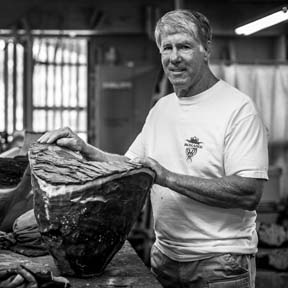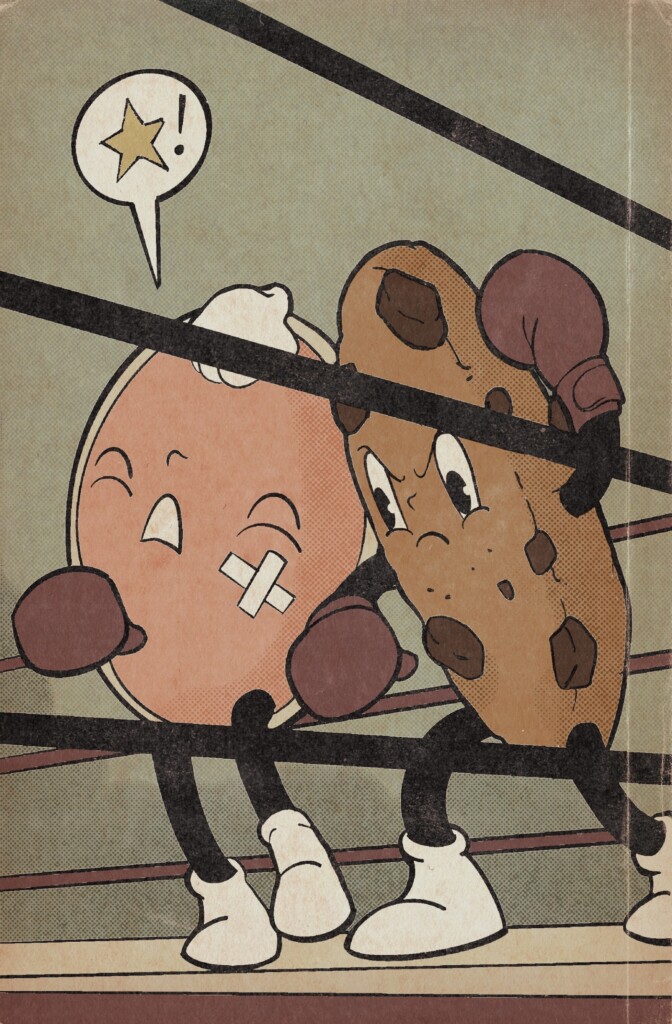
Skip Bellock’s bowls look like an old vinyl record that got left in the heat too long, except that they’re beautiful.
Skip loves natural wood. He looks at a tree stump and imagines what magic he could make turning it into a decorative bowl. He began by making furniture for his home, but it was too flat to be interesting and he moved on to making bowls. His eyes light up as he talks about his love for carving. His woodwork is “about celebrating the life of the tree and preserving its essence by telling its life story.” He began by making small bowls, then larger shallow ones out of woods with difficult grain patterns, such as Russian olive. One of Skip’s most magnificent bowls is large with fluted edges of bark. It is treated with a red dye to show the striations in the wood.
After making shallow bowls he found he wanted more of a challenge. He thought—why not deeper, more interesting bowls? Using trees from local tree cutting services or importing more elaborate wood from Brazil or Australia, Skip carves areas that undulate at different angles resembling ocean waves crashing on different planes. This kind of original carving has made him famous.
Skip and his wife Janeene love to scuba dive in Fiji and other Pacific islands Diving, they see underwater shapes of coral that become patterns for Skip’s deep bowls. For example, in his living room are two nautilus wooden pieces that rest on black bases similar to underwater forms they have seen.
 Finding buyers for his bowls isn’t hard. He sells to galleries in California, Texas, Colorado and Arizona, as well as Park City and the downtown Salt Lake Farmers Market. The process from start to finish goes like this: Skip first nails a rope onto the top of a large tree trunk to determine the shape of the bark edge. This is what makes the bowl unique. Then he uses a chainsaw to carve the rough piece and uses a rotary file for the final shape. All of this is extremely time-consuming, but the step that takes the longest is the sanding. All wood work is sanded to 400 grit, finished with lacquer or oils, and then buffed to a soft sheen.To make the bark around the top edge of the bowl extremely durable, Skip floods it with a resin or epoxy glue.
Finding buyers for his bowls isn’t hard. He sells to galleries in California, Texas, Colorado and Arizona, as well as Park City and the downtown Salt Lake Farmers Market. The process from start to finish goes like this: Skip first nails a rope onto the top of a large tree trunk to determine the shape of the bark edge. This is what makes the bowl unique. Then he uses a chainsaw to carve the rough piece and uses a rotary file for the final shape. All of this is extremely time-consuming, but the step that takes the longest is the sanding. All wood work is sanded to 400 grit, finished with lacquer or oils, and then buffed to a soft sheen.To make the bark around the top edge of the bowl extremely durable, Skip floods it with a resin or epoxy glue.
The final step is putting on the finish of varnish or polyurethane to preserve the wood’s natural beauty. “As a reminder that my work is simply the final step in what Mother Nature started, most of my work leaves a portion of the natural wood untouched.”
Most of Skip’s work sells for between $500 and $5000. But he says the true satisfaction is in the process of imagining and creating the final step in nature’s beauty.§






